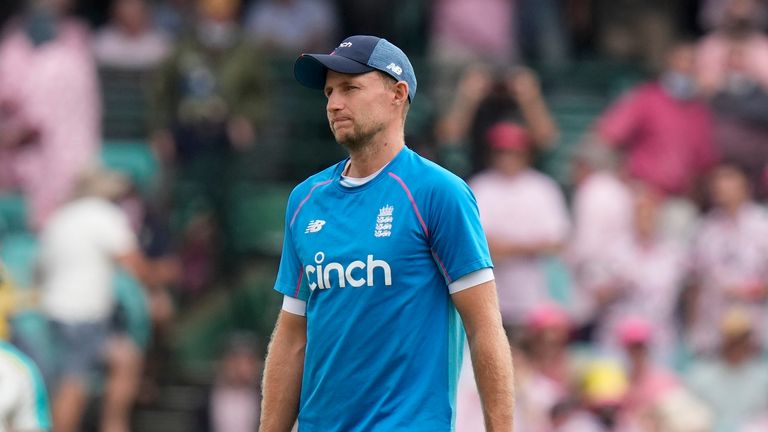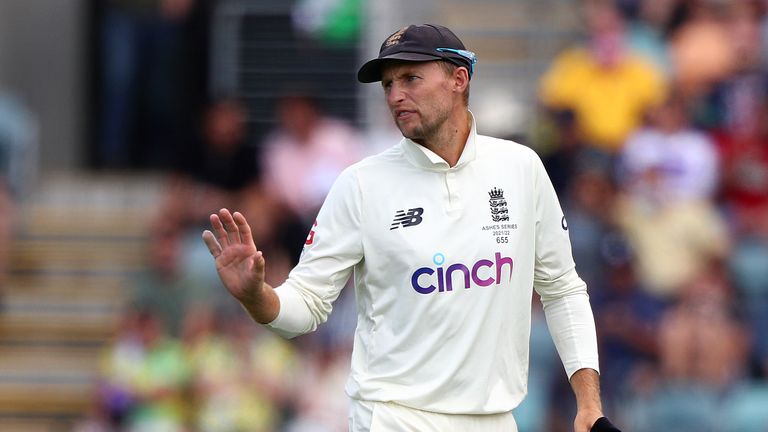Joe Root: Why is England captain moving back to No 3 after career-best year at No 4? | Cricket News

Joe Root has excelled batting at No 4 for England but is moving up a spot for the Test series against West Indies
England’s red-ball reset has begun.
Ashley Giles, Chris Silverwood and Graham Thorpe were relieved of their duties and then, rather more surprisingly, so too were James Anderson and Stuart Broad, at least for the forthcoming tour of the Caribbean.
But amid the discussion of the rights and wrongs of leaving 1,177 Test wickets behind, a seemingly small but rather significant change to how England plan to set up against the West Indies has gone under the radar.
Joe Root may have clung onto the captaincy, but he has relinquished his favoured spot at No 4 in the batting order and will instead come in at first drop – a decision that interim managing director Sir Andrew Strauss insists was instigated by the skipper.


India vs W Indies
February 16, 2022, 1:20pm
Live on
“The first thing he [Root] said in selection was that he was very keen to bat three moving forward,” Strauss told Sky Sports News.
“That came from him; that was his request. And I think everyone agrees that that’s probably a healthy thing for the England cricket team at the moment.”
‘Try and stop that crisis’
The difference between three and four may not seem like much but it is substantial enough that the debate over which of the two positions Root should occupy has been bubbling under – occasionally coming to the boil – for a good five or six years now.
Well, it had been until the England skipper appeared to have put it to bed once and for all with his extraordinary 2021. Batting at four, he scored 1,708 runs at 56.85 with six hundreds.
In a dismal year for England, he was a rare positive so the decision, apparently his own, to try and fix the one component of the batting line-up that wasn’t broken is a strange one.
“It’s an interesting one because a couple of years ago I was calling for that,” former England captain Nasser Hussain told Sky Sports.
“Better judges than me, Ian Chappell and Ricky Ponting, in Australia your best batters bat at three and you go in before the crisis. You try and stop that crisis. Joe Root was constantly going in at a crisis at 20-2, I’d like him in there to stop the crisis at 15-1.
“But the problem is, Root has been prolific batting at four. The problem in Australia was not Anderson and Broad, and it was not Root at four, and they’re the two major changes for the next tour that is coming up.
“They wouldn’t even be on my list – they’ve been the two success stories of English cricket!”
Twenty-five per cent drop off in runs from four to three
It appears even more peculiar when you look at the statistics.
In 106 innings at No 4, Root has 5,179 runs at 51.27 with 14 centuries and 27 fifties. In half as many knocks at No 3, that drops to 1,933 runs at 38.66 and only two hundreds, albeit one of those is his career-high 254, and 14 half-centuries.

Root has scored 14 Test hundreds batting at No 4, including six in 2021
That is a big difference – his output falls by almost 25 per cent when bumped up to three and that is a hell of a lot of runs to be sacrificing for a team that is notoriously short of them.
All of which begs the question: why do it?
23-2, 17-2, 18-2, 29-2, 7-2, 13-2, 12-2, 11-2, 6-2, 1-2. That is just a selection of England’s starts with the bat in the past 12 months and, surely, the primary reason for promoting Root – or rather Root choosing to promote himself.
If he is being exposed to the new ball anyway and scoring shedloads of runs regardless, why not get him in that bit sooner and, as Nasser put it, “stop that crisis” before it has even happened?
The idea that batting at four allows the captain more of a break, mentally more so even than physically, having had to be switched on throughout while the team is in the field, has merit and on the occasions where the top three are able to get England off to a good start – it does happen from time to time – that time with his feet up is clearly valuable.
However, given the frequency with which Root finds himself at the crease within half an hour of the start of the innings, is it more valuable than having your most technically proficient batter in the middle when it is toughest to bat? It would seem not.
Risk and reward
The obvious downside to having your best batter out there for longer, even if it is only a couple of overs more, when the ball is doing so much is that he is more likely to get out – as shown not only by Root’s respective averages, but also by the fact he has as many ducks (four) batting at three as he does at four, in half as many innings in the higher position.
What England are counting on, though, is that a player of Root’s calibre is also capable of putting the pressure back on the bowlers and overcoming the early wicket to set up the innings or, if the openers have gone well, be quickly into his stride and continue the good start – either way, making life that bit easier for those coming in after him.
Unless Joe Root wants to move up to number 3, Ben Stokes would be a good option to bat at 3 in the West Indies – his future in Tests looks to be as a batter who bowls only a bit and Stokes has an excellent defensive technique. England need his runs mor me than his wickets
— Tim Wigmore (@timwig) February 8, 2022
Certainly, in Ben Stokes, who is likely to be shuffled up to No 4 for the first Test in Antigua, Jonny Bairstow and Ollie Pope, England have batters who would relish coming in against a slightly older ball with more freedom to play their shots.
The hope would be that Root is able to likewise once that he has helped lay the groundwork as part of the top three.
The theory is a sound one, were it not for the fact it has been put into practice before without yielding the desired results.
Ahead of the 2019 Ashes, Root was bumped up to three with Joe Denly at four. Root ended the series averaging 32.50, well down on a career figure just shy of 50, while Denly struggled before being moved up to open in the last two Tests and fared far better, notably showing an ability to tough it out against the new ball…
England’s batting remained flaky throughout the series and Root was back at No 4 by their next Test engagement a few months later in New Zealand.
Perhaps the big difference this time is that Root has made the call himself rather than having to be talked into it. Possibly this is a way of showing leadership as he fights to keep hold of the captaincy ahead of the appointment of a new head coach.
He is also coming off the back of a career year and even following a disappointing end to series in Australia, his game could hardly be in a better place. If Root is ever going to make a success of it at No 3 – and given his high standards, that would mean an average pushing 50 – now is the time.
For both player and team though, it is still a big risk.



Pingback: ติดเน็ต ais
Pingback: amanda ghost
Pingback: สล็อต เครดิตฟรี